AWM137 2/1 - Historical information and general development of the RAAF Nursing Service - Notes of History of the RAAF Nursing Service 1940-1944 - Part 1
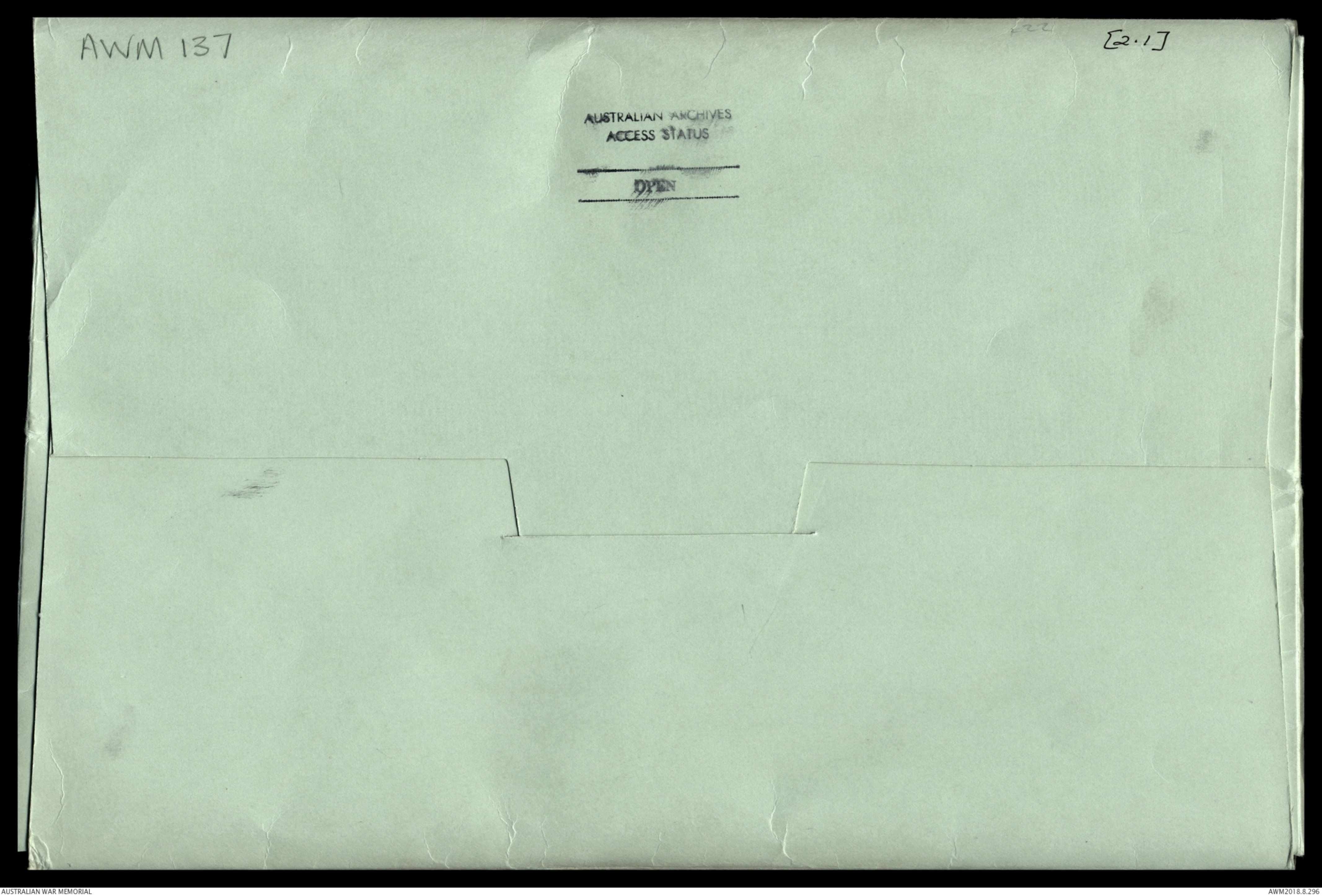
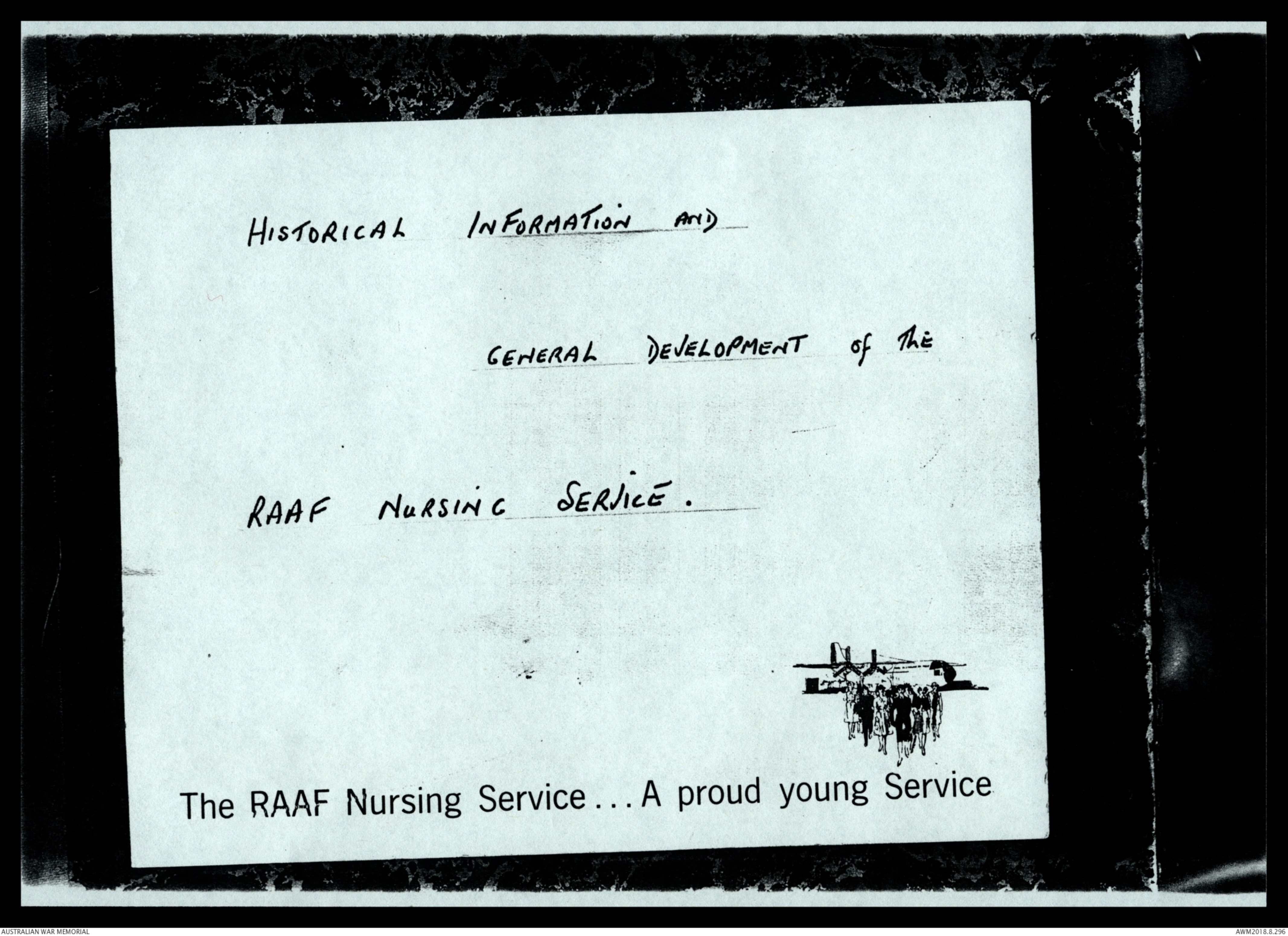
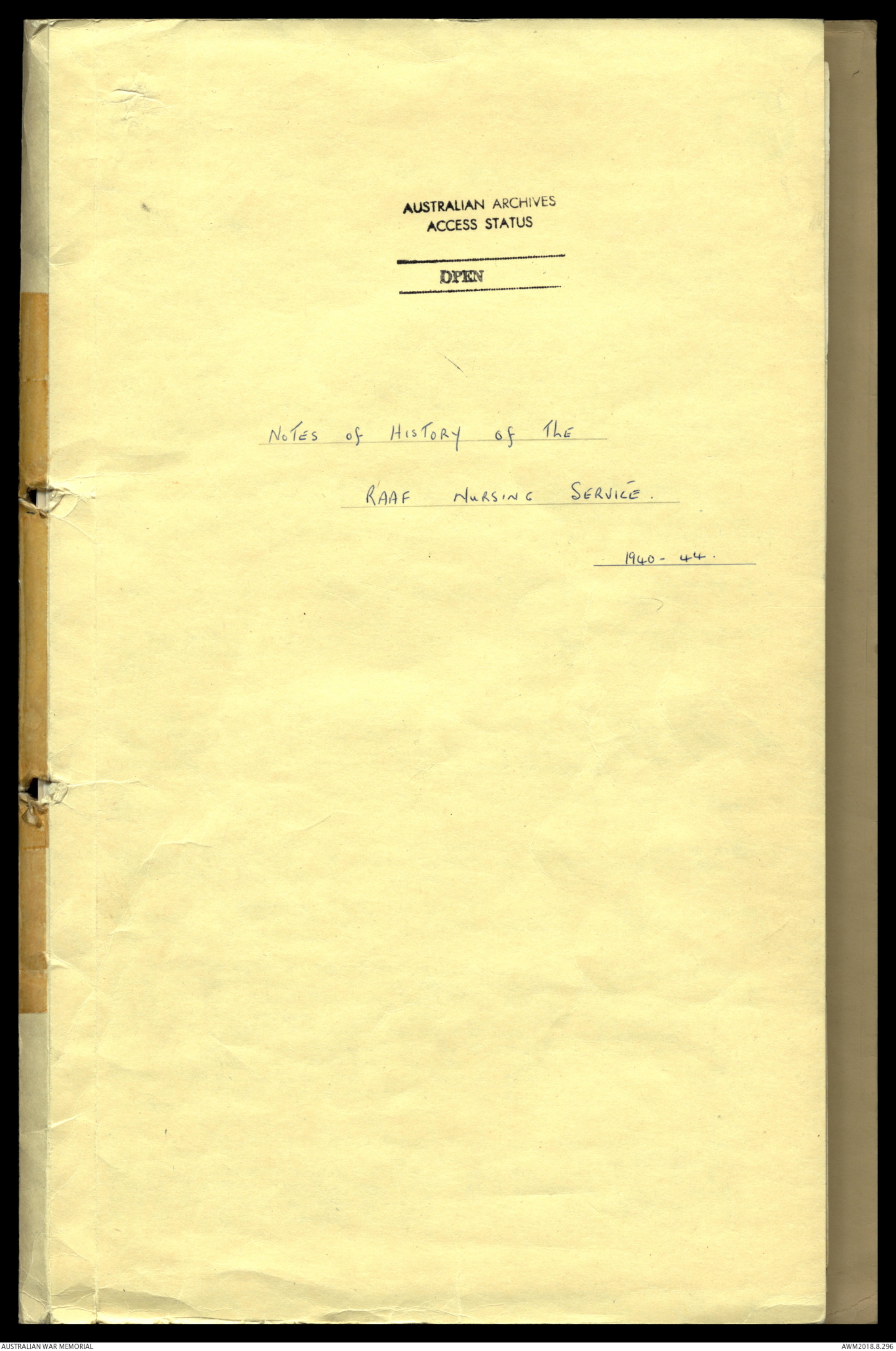
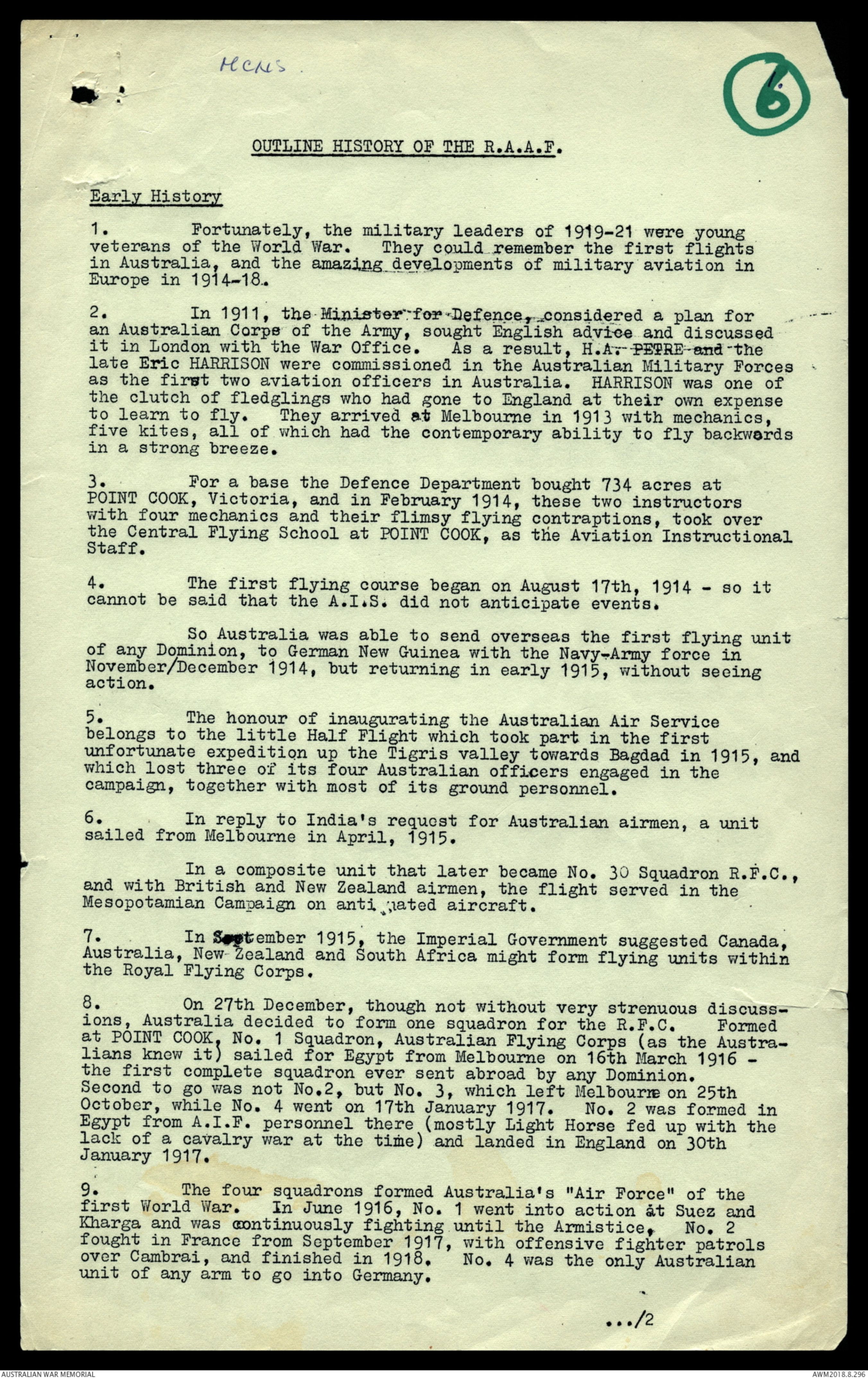
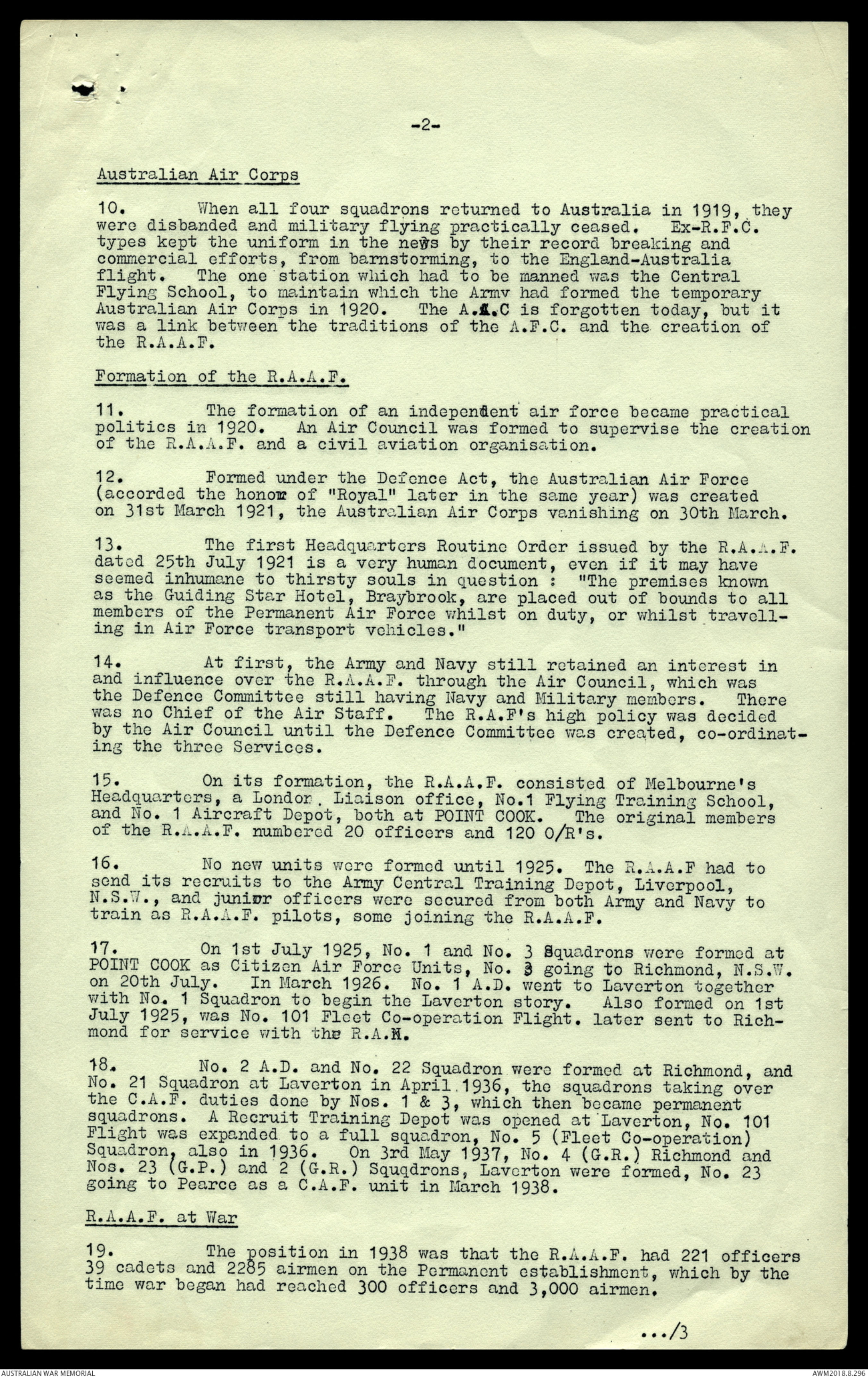
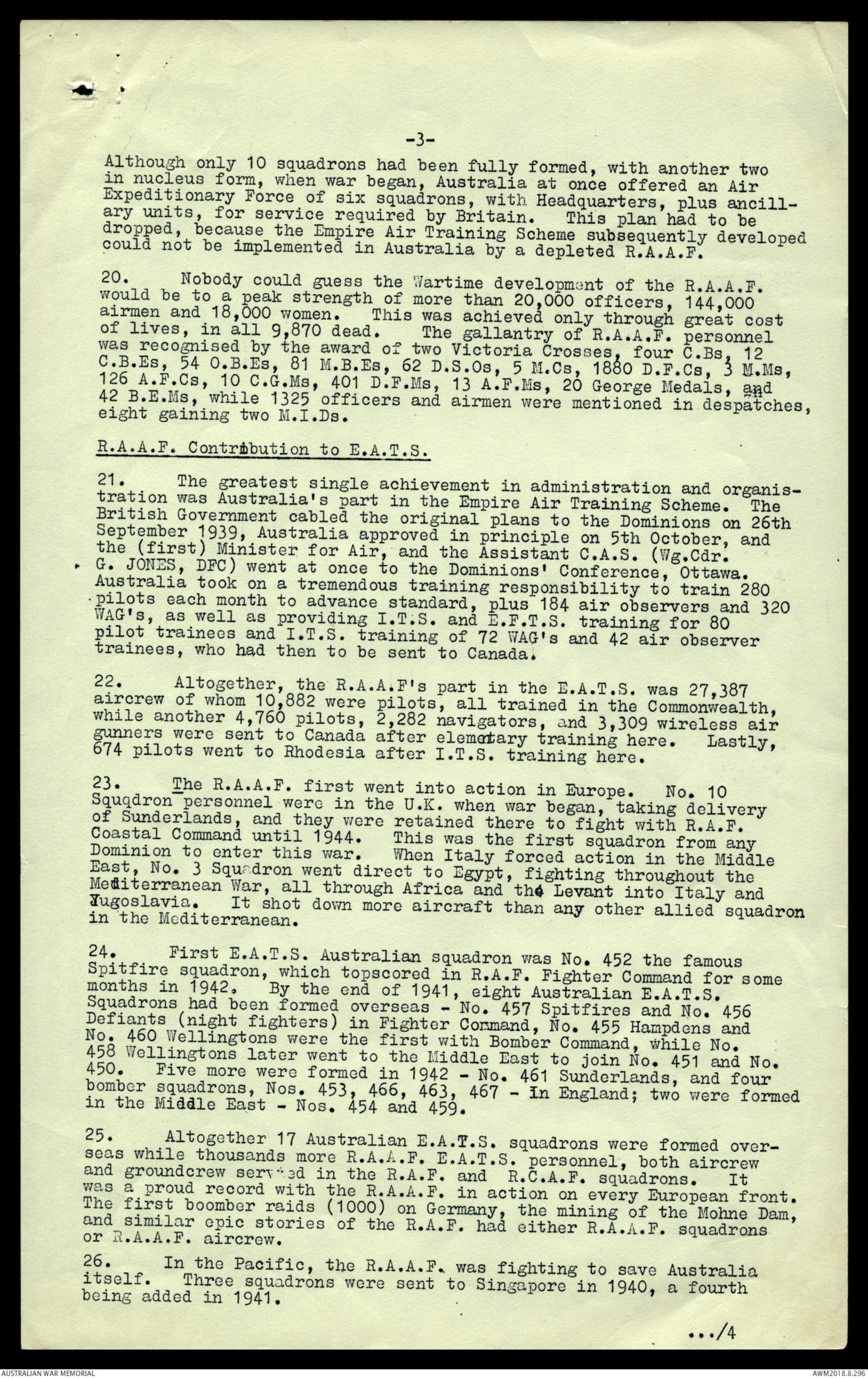
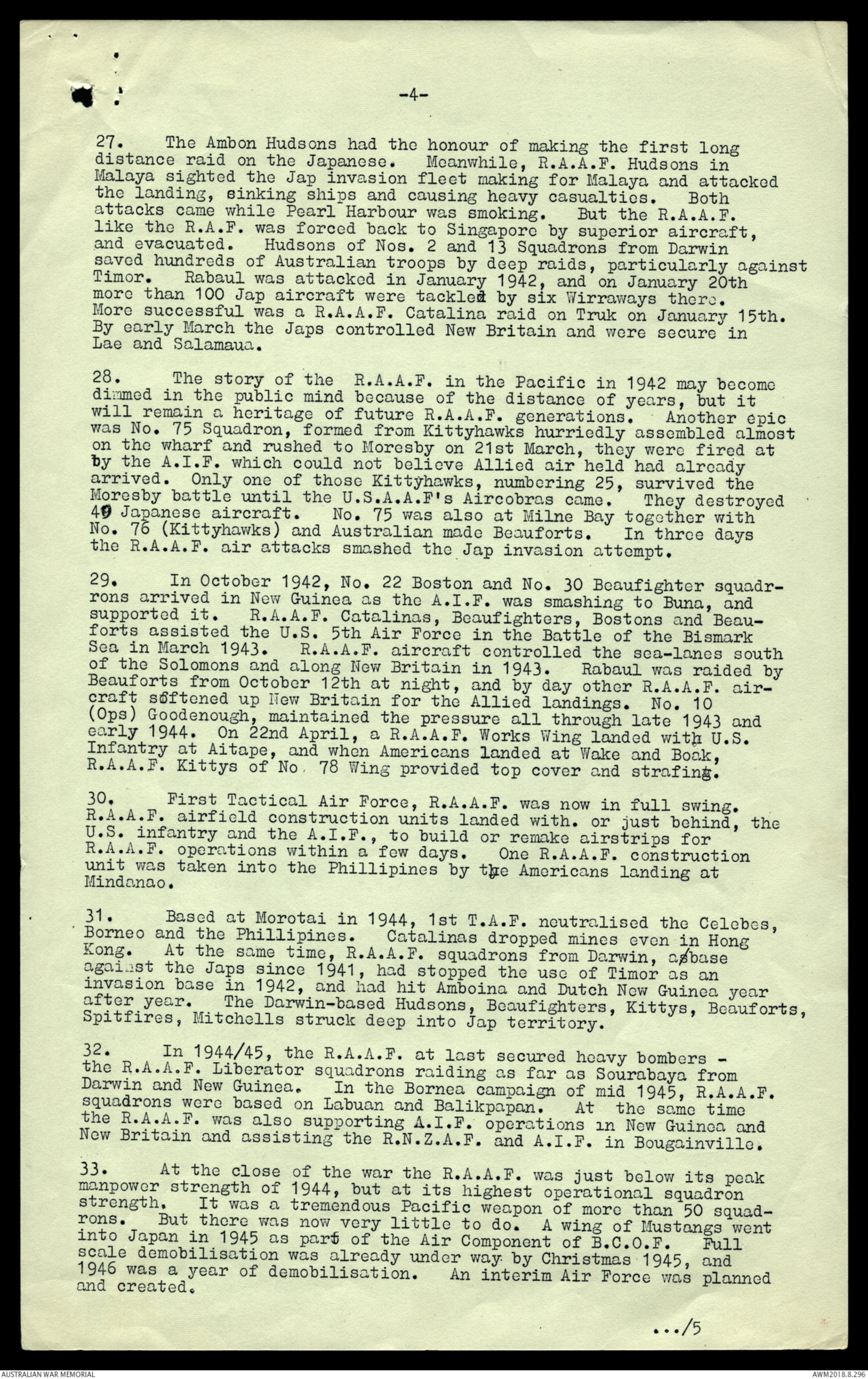
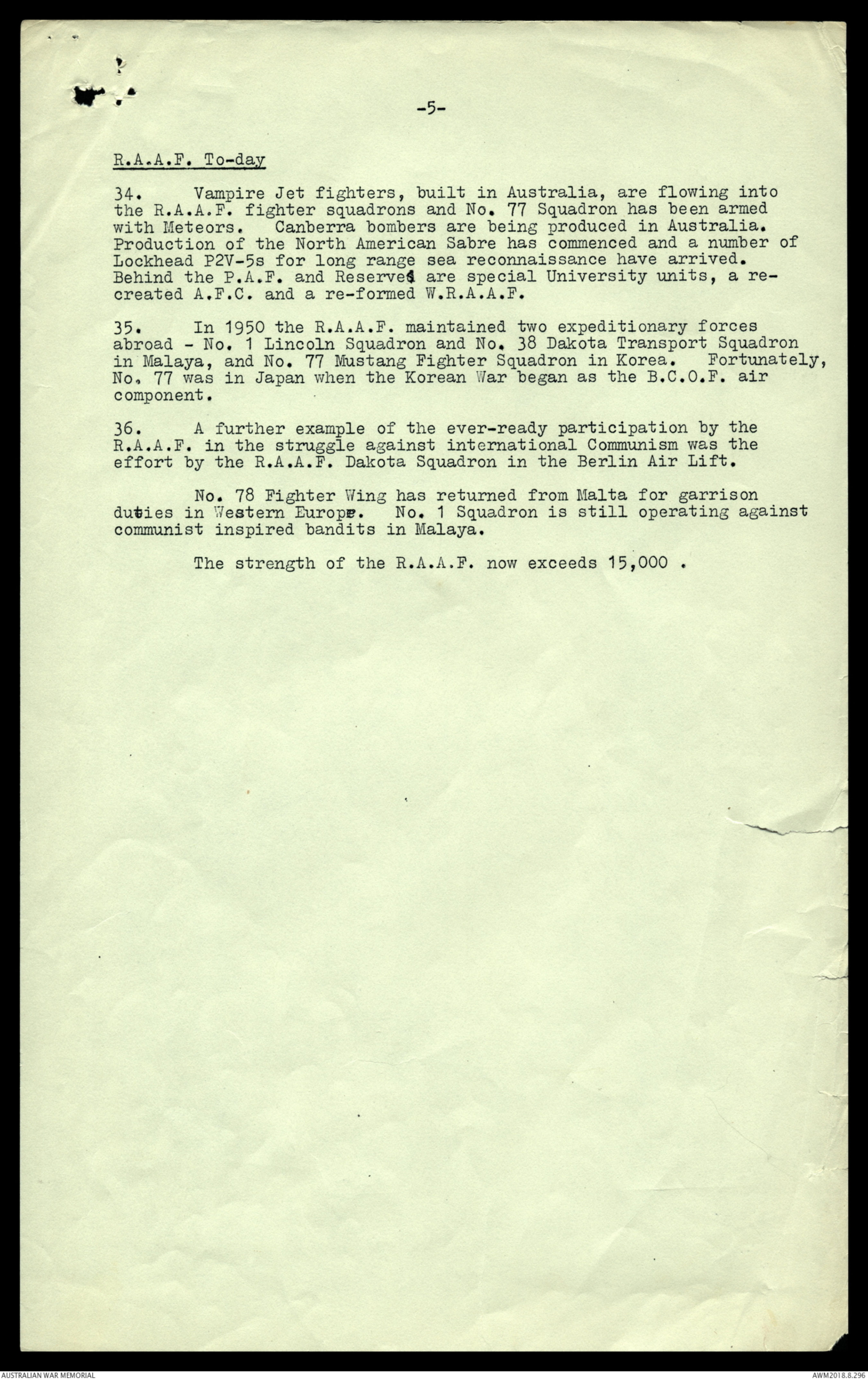
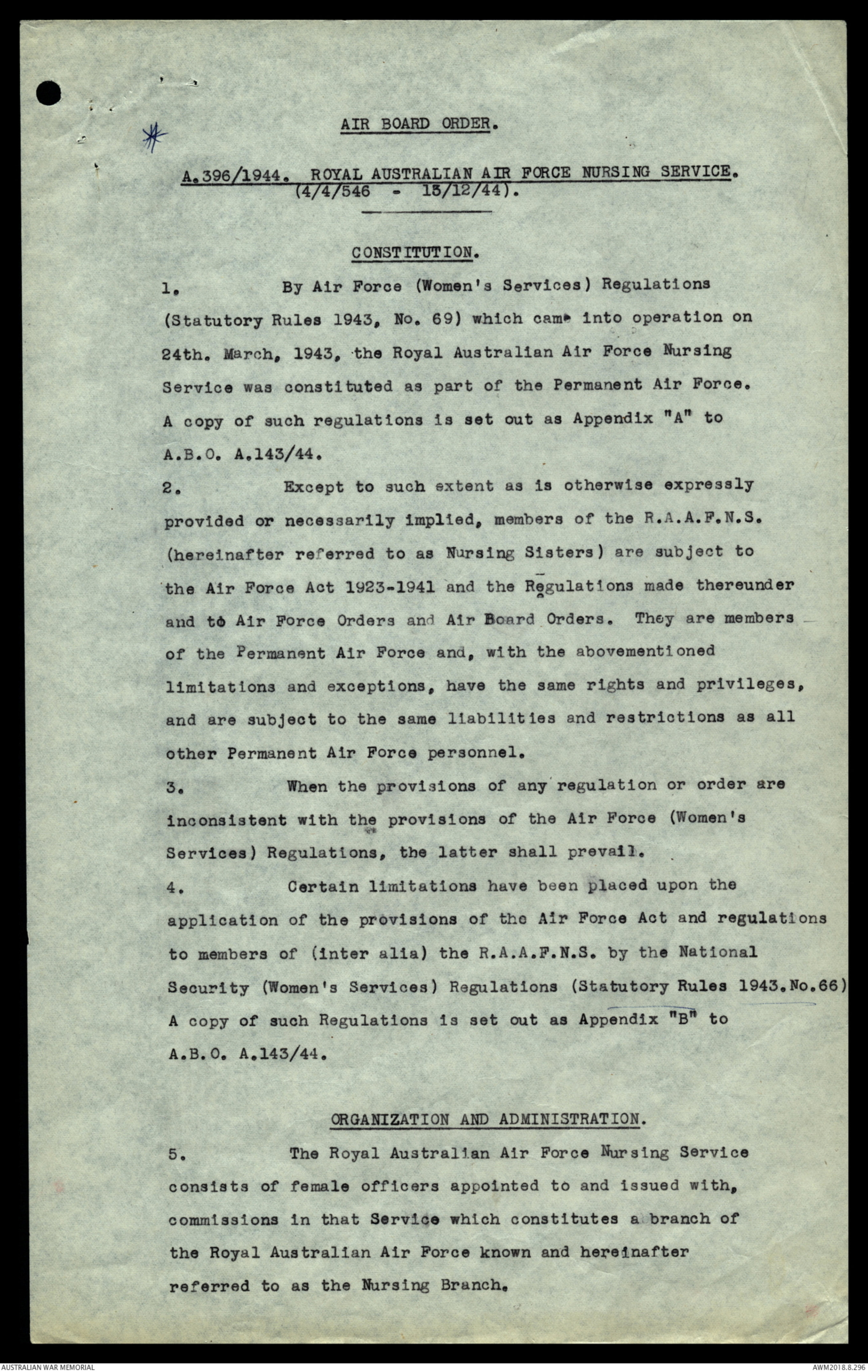
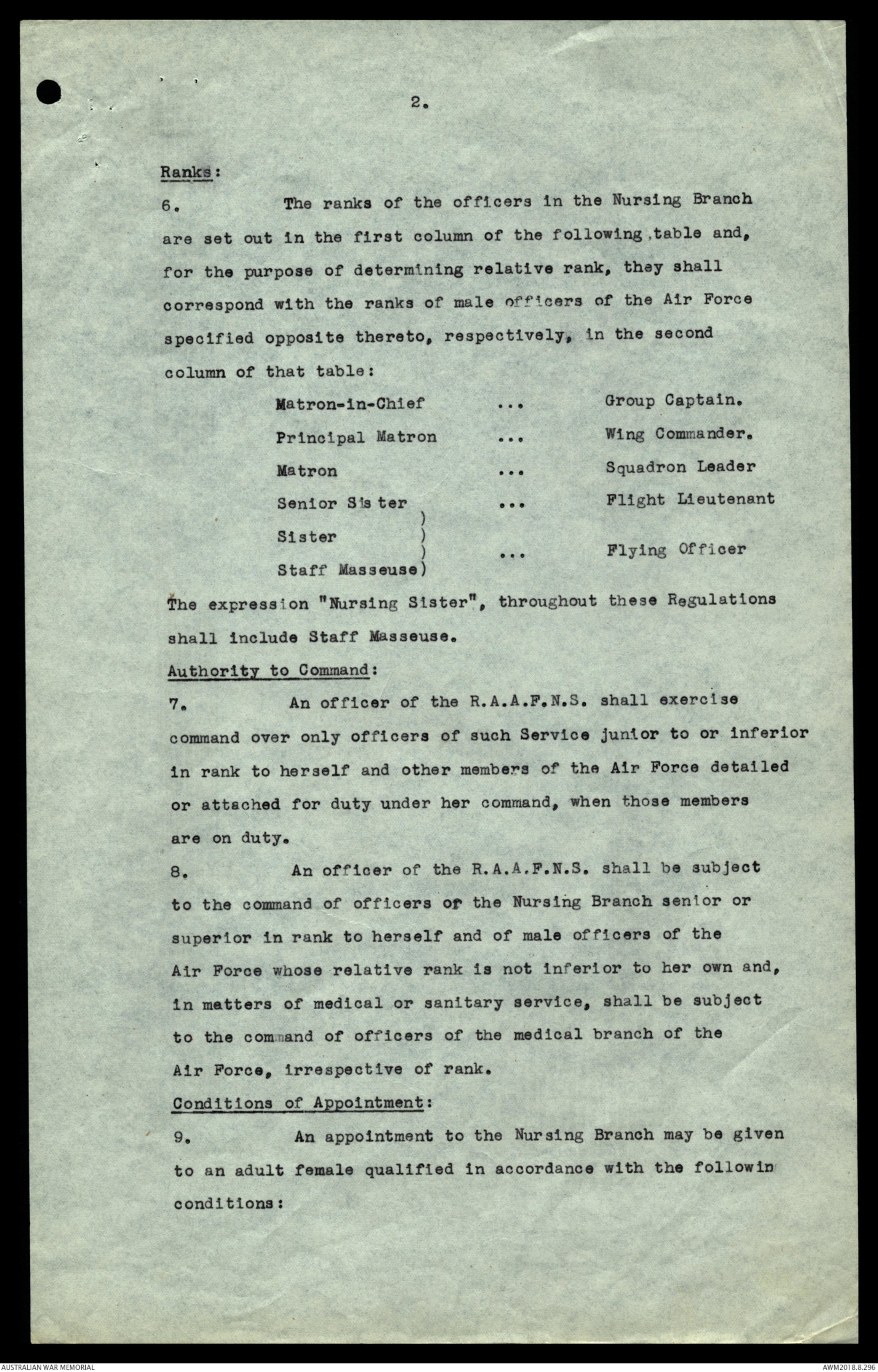
AWM 137 [2.1]
AUSTRALIAN ARCHIVES
ACCESS STATUS
OPEN
HISTORICAL INFORMATION AND
GENERAL DEVELOPMENT OF THE
RAAF NURSING SERVICE.
The RAAF Nursing Service . . . A proud young Service
AUSTRALIAN ARCHIVES
ACCESS STATUS
OPEN
Notes of History of The
RAAF NURSING SERVICE
1940-44
HCNS. 6
OUTLINE HISTORY OF THE R.A.A.F.
Early History
1. Fortunately, the military leaders of 1919-21 were young
veterans of the World War. They could remember the first flights
in Australia, and the amazing developments of military aviation in
Europe in 1914-18.
2. In 1911, the Minister for Defence, considered a plan for
an Australian Corps of the Army, sought English advice and discussed
it in London with the War Office. As a result, H.A. PETRE and the
late Eric HARRISON were commissioned in the Australian Military Forces
as the first two aviation officers in Australia. HARRISON was one of
the clutch of fledglings who had gone to England at their own expense
to learn to fly. They arrived at Melbourne in 1913 with mechanics,
five kites, all of which had the contemporary ability to fly backwards
in a strong breeze.
3. For a base the Defence Department bought 734 acres at
POINT COOK, Victoria, and in February 1914, these two instructors
with four mechanics and their flimsy flying contraptions, took over
the Central Flying School at POINT COOK, as the Aviation Instructional
Staff.
4. The first flying course began on August 17th, 1914 - so it
cannot be said that the A.I.S. did not anticipate events.
So Australia was able to send overseas the first flying unit
of any Dominion, to German New Guinea with the Navy-Army force in
November/December 1914, but returning in early 1915, without seeing
action.
5. The honour of inaugurating the Australian Air Service
belongs to the little Half Flight which took part in the first
unfortunate expedition up the Tigris valley towards Bagdad in 1915, and
which lost three of its four Australian officers engaged in the
campaign, together with most of its ground personnel.
6. In reply to India's request for Australian airmen, a unit
sailed from Melbourne in April, 1915.
In a composite unit that later became No. 30 Squadron R.F.C.,
and with British and New Zealand airmen, the flight served in the
Mesopotamian Campaign on antiquated aircraft.
7. In September 1915, the Imperial Government suggested Canada,
Australia, New Zealand and South Africa might form flying units within
the Royal Flying Corps.
8. On 27th December, though not without very strenuous discussions,
Australia decided to form one squadron for the R.F.C. Formed
at POINT COOK, No. 1 Squadron, Australian Flying Corps (as the Australians
knew it) sailed for Egypt from Melbourne on 16th March 1916 -
the first complete squadron ever sent abroad by any Dominion.
Second to go was not No.2, but No. 3, which left Melbourne on 25th
October, while No. 4 went on 17th January 1917. No. 2 was formed in
Egypt from A.I.F. personnel there (mostly Light Horse fed up with the
lack of a cavalry war at the time) and landed in England on 30th
January 1917.
9. The four squadrons formed Australia's "Air Force" of the
first World War. In June 1916, No. 1 went into action at Suez and
Kharga and was continuously fighting until the Armistice, No. 2
fought in France from September 1917, with offensive fighter patrols
over Cambrai, and finished in 1918. No. 4 was the only Australian
unit of any arm to go into Germany.
.../2
-2-
Australian Air Corps
10. When all four squadrons returned to Australia in 1919, they
were disbanded and military flying practically ceased. Ex-R.F.C.
types kept the uniform in the news by their record breaking and
commercial efforts, from barnstorming, to the England-Australia
flight. The one station which had to be manned was the Central
Flying School, to maintain which the Army had formed the temporary
Australian Air Corps in 1920. The A.A.C is forgotten today, but it
was a link between the traditions of the A.F.C. and the creation of
the R.A.A.F.
Formation of the R.A.A.F.
11. The formation of an independent air force became practical
politics in 1920. An Air Council was formed to supervise the creation
of the R.A.A.F. and a civil aviation organisation.
12. Formed under the Defence Act, the Australian Air Force
(accorded the honor of "Royal" later in the same year) was created
on 31st March 1921, the Australian Air Corps vanishing on 30th March.
13. The first Headquarters Routine Order issued by the R.A.A.F.
dated 25th July 1921 is a very human document, even if it may have
seemed inhumane to thirsty souls in question: "The premises known
as the Guiding Star Hotel, Braybrook, are placed out of bounds to all
members of the Permanent Air Force whilst on duty, or whilst travelling
in Air Force transport vehicles."
14. At first, the Army and Navy still retained an interest in
and influence over the R.A.A.F. through the Air Council, which was
the Defence Committee still having Navy and Military members. There
was no Chief of the Air Staff. The R.A.F's high policy was decided
by the Air Council until the Defence Committee was created, co-ordinating
the three Services.
15. On its formation, the R.A.A.F. consisted of Melbourne's
Headquarters, a London, Liaison office, No.1 Flying Training School,
and No. 1 Aircraft Depot, both at POINT COOK. The original members
of the R.A.A.F. numbered 20 officers and 120 O/R's.
16. No new units were formed until 1925. The R.A.A.F had to
send its recruits to the Army Central Training Depot, Liverpool,
N.S.W., and junior officers were secured from both Army and Navy to
train as R.A.A.F. pilots, some joining the R.A.A.F.
17. On 1st July 1925, No. 1 and No. 3 Squadrons were formed at
POINT COOK as Citizen Air Force Units, No. 3 going to Richmond, N.S.W.
on 20th July. In March 1926. No. 1 A.D. went to Laverton together
with No.1 Squadron to begin the Laverton story. Also formed on 1st
July 1925, was No. 101 Fleet Co-operation Flight. later sent to Richmond
for service with the R.A.N.
18. No. 2 A.D. and No. 22 Squadron were formed at Richmond, and
No. 21 Squadron at Laverton in April 1936, the squadrons taking over
the C.A.F. duties done by Nos. 1 & 3, which then became permanent
squadrons. A Recruit Training Depot was opened at Laverton, No. 101
Flight was expanded to a full squadron, No. 5 (Fleet Co-operation)
Squadron, also in 1936. On 3rd May 1937, No. 4 (G.R.) Richmond and
Nos. 23 (G.P.) and 2 (G.R.) Squqdrons, Laverton were formed, No. 23
going to Pearce as a C.A.F. unit in March 1938.
R.A.A.F. at War
19. The position in 1938 was that the R.A.A.F. had 221 officers
39 cadets and 2285 airmen on the Permanent establishment, which by the
time war began had reached 300 officers and 3,000 airmen.
.../3
-3-
Although only 10 squadrons had been fully formed, with another two
in nucleus form, when war began, Australia at once offered an Air
Expeditionary Force of six squadrons, with Headquarters, plus ancillary
units, for service required by Britain. This plan had to be
dropped, because the Empire Air Training Scheme subsequently developed
could not be implemented in Australia by a depleted R.A.A.F.
20. Nobody could guess the Wartime development of the R.A.A.F.
would be to a peak strength of more than 20,000 officers, 144,000
airmen and 18,000 women. This was achieved only through great cost
of lives, in all 9,870 dead. The gallantry of R.A.A.F. personnel
was recognised by the award of two Victoria Crosses, four C.Bs, 12
C.B.Es, 54 O.B.Es, 81 M.B.Es, 62 D.S.Os, 5 M.Cs, 1880 D.F.Cs, 3 M.Ms,
126 A.F.Cs, 10 C.G.Ms, 401 D.F.Ms, 13 A.F.Ms, 20 George Medals, and
42 B.E.Ms, while 1325 officers and airmen were mentioned in despatches,
eight gaining two M.I.Ds.
R.A.A.F. Contribution to E.A.T.S.
21. The greatest single achievement in administration and organistration
was Australia's part in the Empire Air Training Scheme. The
British Government cabled the original plans to the Dominions on 26th
September 1939, Australia approved in principle on 5th October, and
the (first) Minister for Air, and the Assistant C.A.S. (Wg.Cdr.
G. JONES, DFC) went at once to the Dominions' Conference, Ottawa.
Australia took on a tremendous training responsibility to train 280
pilots each month to advance standard, plus 184 air observers and 320
WAG's, as well as providing I.T.S. and E.F.T.S. training for 80
pilot trainees and I.T.S. training of 72 WAG's and 42 air observer
trainees, who had then to be sent to Canada.
22. Altogether, the R.A.A.F's part in the E.A.T.S. was 27,387
aircrew of whom 10,882 were pilots, all trained in the Commonwealth,
while another 4,760 pilots, 2,282 navigators, and 3,309 wireless air
gunners were sent to Canada after elementary training here. Lastly,
674 pilots went to Rhodesia after I.T.S. training here.
23. The R.A.A.F. first went into action in Europe. No. 10
Squqdron personnel were in the U.K. when war began, taking delivery
of Sunderlands, and they were retained there to fight with R.A.F.
Coastal Command until 1944. This was the first squadron from any
Dominion to enter this war. When Italy forced action in the Middle
East, No. 3 Squadron went direct to Egypt, fighting throughout the
Mediterranean War, all through Africa and the Levant into Italy and
Yugoslavia. It shot down more aircraft than any other allied squadron
in the Mediterranean.
24. First E.A.T.S. Australian squadron was No. 452 the famous
Spitfire squadron, which topscored in R.A.F. Fighter Command for some
months in 1942. By the end of 1941, eight Australian E.A.T.S.
Squadrons had been formed overseas - No. 457 Spitfires and No. 456
Defiants (night fighters) in Fighter Command, No. 455 Hampdens and
No. 460 Wellingtons were the first with Bomber Command, while No.
458 Wellingtons later went to the Middle East to join No. 451 and No.
450. Five more were formed in 1942 - No. 461 Sunderlands, and four
bomber squadrons, Nos. 453, 466, 463, 467 - in England; two were formed
in the Middle East - Nos. 454 and 459.
25. Altogether 17 Australian E.A.T.S. squadrons were formed overseas
while thousands more R.A.A.F. E.A.T.S. personnel, both aircrew
and groundcrew served in the R.A.F. and R.C.A.F. squadrons. It
was a proud record with the R.A.A.F. in action on every European front.
The first boomber raids (1000) on Germany, the mining of the Mohne Dam,
and similar epic stories of the R.A.F. had either R.A.A.F. squadrons
or R.A.A.F. aircrew.
26. In the Pacific, the R.A.A.F. was fighting to save Australia
itself. Three squadrons were sent to Singapore in 1940, a fourth
being added in 1941.
.../4
-4-
27. The Ambon Hudsons had the honour of making the first long
distance raid on the Japanese. Meanwhile, R.A.A.F. Hudsons in
Malaya sighted the Jap invasion fleet making for Malaya and attacked
the landing, sinking ships and causing heavy casualties. Both
attacks came while Pearl Harbour was smoking. But the R.A.A.F.
like the R.A.F. was forced back to Singapore by superior aircraft,
and evacuated. Hudsons of Nos. 2 and 13 Squadrons from Darwin
saved hundreds of Australian troops by deep raids, particularly against
Timor. Rabaul was attacked in January 1942, and on January 20th
more than 100 Jap aircraft were tackled by six Wirraways there.
More successful was a R.A.A.F. Catalina raid on Truk on January 15th.
By early March the Japs controlled New Britain and were secure in
Lae and Salamaua.
28. The story of the R.A.A.F. in the Pacific in 1942 may become
dimmed in the public mind because of the distance of years, but it
will remain a heritage of future R.A.A.F. generations. Another epic
was No. 75 Squadron, formed from Kittyhawks hurriedly assembled almost
on the wharf and rushed to Moresby on 21st March, they were fired at
by the A.I.F. which could not believe Allied air held had already
arrived. Only one of those Kittyhawks, numbering 25, survived the
Moresby battle until the U.S.A.A.F's Aircobras came. They destroyed
40 Japanese aircraft. No. 75 was also at Milne Bay together with
No. 76 (Kittyhawks) and Australian made Beauforts. In three days
the R.A.A.F. air attacks smashed the Jap invasion attempt.
29. In October 1942, No. 22 Boston and No. 30 Beaufighter squadrrons
arrived in New Guinea as the A.I.F. was smashing to Buna, and
supported it. R.A.A.F. Catalinas, Beaufighters, Bostons and Beauforts
assisted the U.S. 5th Air Force in the Battle of the Bismark
Sea in March 1943. R.A.A.F. aircraft controlled the sea-lanes south
of the Solomons and along New Britain in 1943. Rabaul was raided by
Beauforts from October 12th at night, and by day other R.A.A.F. aircraft
softened up New Britain for the Allied landings. No. 10
(Ops) Goodenough, maintained the pressure all through late 1943 and
early 1944. On 22nd April, a R.A.A.F. Works Wing landed with U.S.
Infantry at Aitape, and when Americans landed at Wake and Boak,
R.A.A.F. Kittys of No. 78 Wing provided top cover and strafing.
30. First Tactical Air Force, R.A.A.F. was now in full swing.
R.A.A.F. airfield construction units landed with. or just behind, the
U.S. infantry and the A.I.F., to build or remake airstrips for
R.A.A.F. operations within a few days. One R.A.A.F. construction
unit was taken into the Phillipines by the Americans landing at
Mindanao.
31. Based at Morotai in 1944, 1st T.A.F. neutralised the Celebes,
Borneo and the Phillipines. Catalinas dropped mines even in Hong
Kong. At the same time, R.A.A.F. squadrons from Darwin, asbase
against the Japs since 1941, had stopped the use of Timor as an
invasion base in 1942, and had hit Amboina and Dutch New Guinea year
after year. The Darwin-based Hudsons, Beaufighters, Kittys, Beauforts,
Spitfires, Mitchells struck deep into Jap territory.
32. In 1944/45, the R.A.A.F. at last secured heavy bombers -
the R.A.A.F. Liberator squadrons raiding as far as Sourabaya from
Darwin and New Guinea. In the Bornea campaign of mid 1945, R.A.A.F.
squadrons were based on Labuan and Balikpapan. At the same time
the R.A.A.F. was also supporting A.I.F. operations in New Guinea and
New Britain and assisting the R.N.Z.A.F. and A.I.F. in Bougainville.
33. At the close of the war the R.A.A.F. was just below its peak
manpower strength of 1944, but at its highest operational squadron
strength. It was a tremendous Pacific weapon of more than 50 squadrons.
But there was now very little to do. A wing of Mustangs went
into Japan in 1945 as part of the Air Component of B.C.O.F. Full
scale demobilisation was already under way by Christmas 1945, and
1946 was a year of demobilisation. An interim Air Force was planned
and created.
.../5
-5-
R.A.A.F. To-day
34. Vampire Jet fighters, built in Australia, are flowing into
the R.A.A.F. fighter squadrons and No. 77 Squadron has been armed
with Meteors. Canberra bombers are being produced in Australia.
Production of the North American Sabre has commenced and a number of
Lockhead P2V-5s for long range sea reconnaissance have arrived.
Behind the P.A.F. and Reserves are special University units, a recreated
A.F.C. and a re-formed W.R.A.A.F.
35. In 1950 the R.A.A.F. maintained two expeditionary forces
abroad - No. 1 Lincoln Squadron and No. 38 Dakota Transport Squadron
in Malaya, and No. 77 Mustang Fighter Squadron in Korea. Fortunately,
No. 77 was in Japan when the Korean War began as the B.C.O.F. air
component.
36. A further example of the ever-ready participation by the
R.A.A.F. in the struggle against international Communism was the
effort by the R.A.A.F. Dakota Squadron in the Berlin Air Lift.
No. 78 Fighter Wing has returned from Malta for garrison
duties in Western Europe. No. 1 Squadron is still operating against
communist inspired bandits in Malaya.
The strength of the R.A.A.F. now exceeds 15,000.
AIR BOARD ORDER.
A.369/1944. ROYAL AUSTRALIAN AIR FORCE NURSING SERVICE.
(4/4/546 - 13/12/44).
CONSTITUTION.
1. By Air Force (Women's Services) Regulations
(Statutory Rules 1943, No. 69) which came into operation on
24th. March, 1943, the Royal Australian Air Force Nursing
Service was constituted as part of the Permanent Air Force.
A copy of such regulations is set out as Appendix "A" to
A.B.O. A.143/44.
2. Except to such extent as is otherwise expressly
provided or necessarily implied, members of the R.A.A.F.N.S.
(hereinafter referred to as Nursing Sisters) are subject to
the Air Force Act 1923-1941 and the Regulations made thereunder
and to Air Force Orders and Air Board Orders. They are members
of the Permanent Air Force and, with the abovementioned
limitations and exceptions, have the same rights and privileges,
and are subject to the same liabilities and restrictions as all
other Permanent Air Force personnel.
3. When the provisions of any regulation or order are
inconsistent with the provisions of the Air Force (Women's
Services) Regulations, the latter shall prevail.
4. Certain limitations have been placed upon the
application of the provisions of the Air Force Act and regulations
to members of (inter alia) the R.A.A.F.N.S. by the National
Security (Women's Services) Regulations (Statutory Rules 1943.No.66)
A copy of such Regulations is set out as Appendix "B" to
A.B.O. A.143/44.
ORGANIZATION AND ADMINISTRATION.
5. The Royal Australian Air Force Nursing Service
consists of female officers appointed to and issued with,
commissions in that Service which constitutes a branch of
the Royal Australian Air Force known and hereinafter
referred to as the Nursing Branch.
2.
Ranks:
6. The ranks of the officers in the Nursing Branch
are set out in the first column of the following table and,
for the purpose of determining relative rank, they shall
correspond with the ranks of male officers of the Air Force
specified opposite thereto, respectively, in the second
column of that table:
Matron-in-Chief ... Group Captain.
Principal Matron ... Wing Commander.
Matron ... Squadron Leader
Senior Sister ... Flight Lieutenant
Sister ) ... Flying Officer
Staff Masseuse)
The expression "Nursing Sister", throughout these Regulations
shall include Staff Masseuse.
Authority to Command:
7. An officer of the R.A.A.F.N.S. shall exercise
command over only officers of such Service junior to or inferior
in rank to herself and other members of the Air Force detailed
or attached for duty under her command, when those members
are on duty.
8. An officer of the R.A.A.F.N.S. shall be subject
to the command of officers or the Nursing Branch senior or
superior in rank to herself and of male officers of the
Air Force whose relative rank is not inferior to her own and,
in matters of medical or sanitary service, shall be subject
to the command of officers of the medical branch of the
Air Force, irrespective of rank.
Conditions of Appointment:
9. An appointment to the Nursing Branch may be given
to an adult female qualified in accordance with the following
conditions:
 Not Yet Replaced By AI
Not Yet Replaced By AIThis transcription item is now locked to you for editing. To release the lock either Save your changes or Cancel.
This lock will be automatically released after 60 minutes of inactivity.